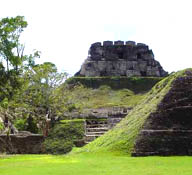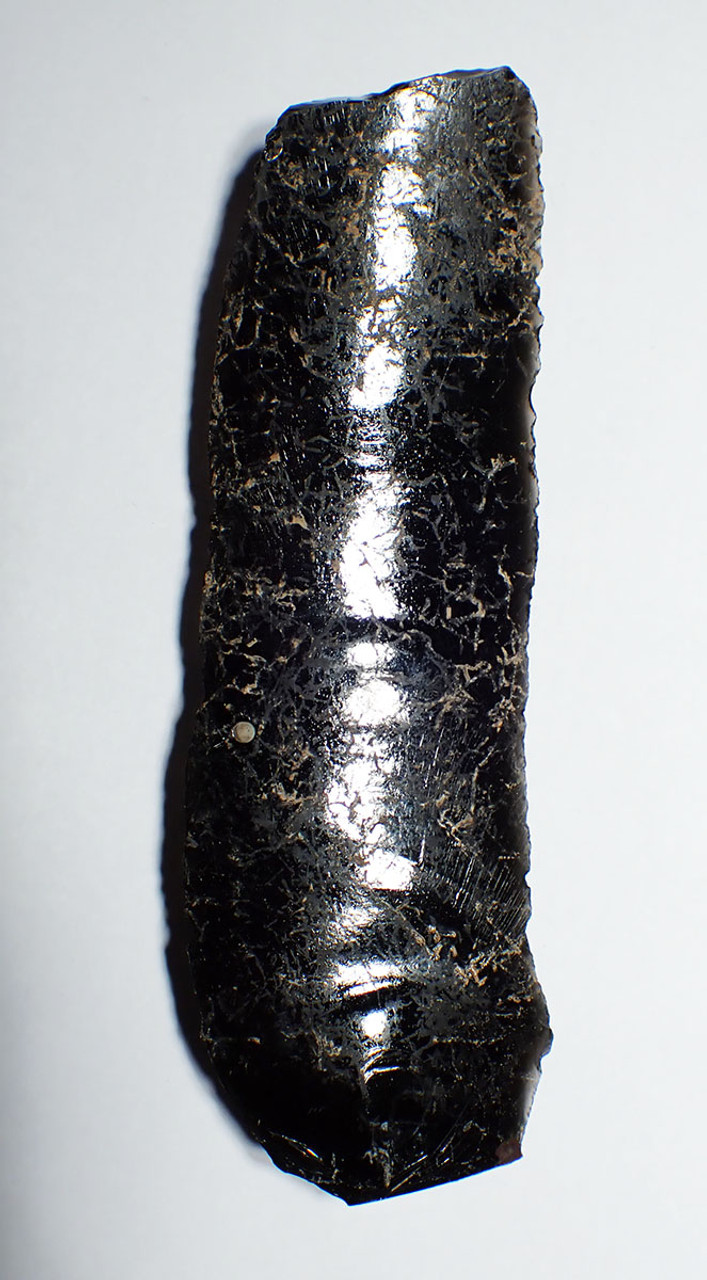Product Description
SEE MORE PRE-COLUMBIAN ARTIFACTS
This LARGE core struck obsidian blade knife was made by the Pre-Columbian Mayan people of Mesoamerica. Blades like these were used in a variety of tasks, and feared for their incredible sharpness when incorporated in weapons of war. What makes this example extraordinary and defines it as a ceremonial, ritual cutting tool is the presence of ancient applied red cinnabar pigment that still exists on portions of the surface. The photos show close-up images of this. This blade was once fully pigmented with ritual cinnabar. Cinnabar, a crimson mercury sulfide mineral, was heavily used by the ancient Maya civilization for decorative and ceremonial purposes, particularly for its vibrant red color. The Maya associated the color red with blood and life force, making cinnabar a sacred substance. The Mayans incorporated cinnabar into burial rituals and sacrifice offerings. Cinnabar was believed to be able to animate an object, or even the dead. By placing cinnabar pigment on this blade, it was dedicated as being extremely special to some ceremony. Sharp blades like this would have been necessary to perform a variety of sacrificial tasks. Some victims were flayed, some were dismembered after death. Ritual bloodletting ceremonies were also popular and a large blade like this would have been better for use in that it would have been visible for public display rituals. Whatever the purpose, we know for a fact this was a ritual weapon based on the presence of cinnabar. Cinnabar was never applied to ordinary tools or used in any everyday purpose.
This large and broad example is complete with evidence of ancient use wear and re-sharpening to the cutting edges. There is no damage to the blade and it is in the finest preservation. Mineral deposits and root deposits on the flat side, provide irrefutable proof of its ancient origin and original, unaltered condition.
Mineral and sediment can be seen deep in flake scars which are indicators ONLY found in AUTHENTIC specimens such as this. Caution must be applied in acquiring ancient obsidian artifacts because the stone does not patinate on the surface like other lithic types.
Obsidian was prized by the ancient Pre-Columbian Indians and even today, it is still used in modern medicine for scalpel blades as obsidian can flake to an edge one molecule thick, thereby attaining a level of sharpness impossible to achieve with a steel scalpel. As a matter of fact, aside from using lasers in modern surgery, the preferred scalpel is one from obsidian. Because of its sharpness, obsidian leaves less of a scar and does less tissue damage than a scalpel or knife made of any other substance known to Man. Obsidian is 15 times sharper than surgical steel, It’s no wonder that obsidian became a valuable tool in medicine and warfare when you consider that at an obsidian scalpel can rival diamond in the fineness of its edge. Common household razor blade edges are 100 times thicker than the edge of struck obsidian!
From the Dr. Medina Pre-Columbian collection dating to the 1950's, of which a notarized acquisition letter and documentation will be provided to the buyer.
HISTORY
 Of all the ancient cultures of the Americas, no civilization has held more intrigue and secrets for so long as that of the Mayans. In 1960, their language code of glyphs was finally deciphered and forever changed our view of what we initially thought was a peaceful and harmonious society. On the contrary, the Mayan Culture of the latter years was bathed in the blood of vicious warfare and astounding levels of human sacrifice. Their technology was so advanced it is no wonder many believe they received intelligence from extra-terrestrials. Despite our recent discoveries of Mayan mathematics, astronomy and calendar technology, the Mayans still leave us with many mysteries. Their love of war caused them to manufacture spectacular weapons with inherent beauty and artistry. Their ceramics depict a fascinating culture of status, sacrifice and deep religious devotion to a number of strange gods.
Of all the ancient cultures of the Americas, no civilization has held more intrigue and secrets for so long as that of the Mayans. In 1960, their language code of glyphs was finally deciphered and forever changed our view of what we initially thought was a peaceful and harmonious society. On the contrary, the Mayan Culture of the latter years was bathed in the blood of vicious warfare and astounding levels of human sacrifice. Their technology was so advanced it is no wonder many believe they received intelligence from extra-terrestrials. Despite our recent discoveries of Mayan mathematics, astronomy and calendar technology, the Mayans still leave us with many mysteries. Their love of war caused them to manufacture spectacular weapons with inherent beauty and artistry. Their ceramics depict a fascinating culture of status, sacrifice and deep religious devotion to a number of strange gods.
Archaeologists divide the Mayan Culture into different periods - LATE PRE-CLASSIC / PROTO-CLASSIC (300 BC - 300 AD), EARLY CLASSIC (300 AD - 600 AD), LATE CLASSIC (600 AD - 830 AD), TERMINAL CLASSIC (830 AD - 950 AD). The earliest days of the Maya date back to 2000 BC when small farming villages first appeared in the highlands and Pacific coastline of Guatemala. Crops such as corn, squash and beans made up the staple of their diet and are believed to have been brought from previous migration through Mexico. The Maya pottery styles were unique to the early Maya settlements, though. By 1000 BC, villages sprang up in the lowland regions. The Maya lived in the same locations for centuries and in a continuous state of architectural improvement and expansion leading up to the magnificent 'super-cities' we associate with them today. By 300 AD. full-scale cities were being built with stone featuring massive plazas, temples and pyramids reaching 20 stories high.
Human sacrifice in Maya culture was the ritual offering of nourishment to the gods and goddesses. Blood was viewed as a potent source of nourishment for the Maya deities, and the sacrifice of a living creature was a powerful blood offering. By extension, the sacrifice of human life was the ultimate offering of blood to the gods, and the most important Maya rituals culminated in human sacrifice. Generally, only high-status prisoners of war were sacrificed, and lower status captives were used for labor.
Human sacrifice among the Maya is evident from at least the Classic period (c. AD 250–900) right through to the final stages of the Spanish conquest in the 17th century. Human sacrifice is depicted in Classic Maya art, is mentioned in Classic period glyph texts and has been verified archaeologically by analysis of skeletal remains from the Classic and Postclassic (c. AD 900–1524) periods. Additionally, human sacrifice is described in a number of late Maya and early Spanish colonial texts, including the Madrid Codex, the Kʼicheʼ epic Popol Vuh, the Kʼicheʼ Título de Totonicapán, the Kʼicheʼ language Rabinal Achi, the Annals of the Kaqchikels, the Yucatec Songs of Dzitbalche and Diego de Landa's Relación de las cosas de Yucatán.
Important rituals such as the dedication of major building projects or the enthronement of a new ruler required a human sacrificial offering. The sacrifice of an enemy king was the most prized offering, and such a sacrifice involved the decapitation of the captive ruler in a ritual reenactment of the decapitation of the Maya maize god by the Maya death gods. Sacrifice by decapitation is depicted in Classic period Maya art, and sometimes took place after the victim was tortured, being variously beaten, scalped, burnt or disembowelled. Sacrifice by decapitation is depicted on reliefs at Chichen Itza in two of the ballcourts (the Great Ballcourt and the Monjas Ballcourt).
Heart extractions and sacrifice have been viewed as a “supreme religious expression among the ancient Maya". The removal of the still-beating heart, or sometimes self-immolation, was considered a great offering and meal for the gods. It began with a dispersal of blood extracted either, from the mouth, nose, ears, fingers, or penis, typically with a sharp tool made from animal bone, such as a stingray spine. The victim would then be positioned on a stone or wooden altar, and access to the heart would be achieved with a variety of procedures and techniques. Most of these techniques were proved by examination of the post-mortem injuries on bones surrounding the heart, such as the sternum, and ribs. Methods include vertical axial sternotomy, left transverse thoracotomy, transverse bilateral sternothoracotamy, or transdiaphragmatic access. The preferred method was most probably from below the diaphragm, as this allowed for easy access and not much blockage from bones (nicks, segmenting, and fracturing of the sternum and ribs indicate this). After which, the heart was exposed to retrieval. If accessed through the sternum, the ribs would be cut and pulled apart, or if via the diaphragm, tissue would be cut. The actual removal of the heart was achieved by cutting the attaching ligaments with a bifacial tool. Finally, offering of the heart would take place with either special positioning or through burning. At this time, blood would also be collected from the victim. The ritual will end with mutilation of the body, usually through dismemberment, or burned. They would then dispose of the body or re-utilize it for other purposes.
References:
- Fiedel, Stuart J., Prehistory of the Americas, 1992 - Freeman and Company, Early Man in America, 1973
- Hirth Kenneth, Obsidian Craft Production in Ancient Central Mexico, 2006
- Muser, Curt, Facts and Artifacts of Ancient Middle America, 1978
- Phillips, Charles, The Complete Illustrated History of the Aztec and Maya, 2008
- Tiesler, Vera; Cucina, Andrea (20 January 2017). "Procedures in Human Heart Extraction and Ritual Meaning: A Taphonomic Assessment of Anthropogenic Marks in Classic Maya Skeletons". Latin American Antiquity (17)
- Moser, Christopher L. (1973). "Human decapitation in ancient Mesoamerica". Studies in Pre-Columbian Art and Archaeology (11)
 US DOLLAR
US DOLLAR
 EURO
EURO
 AUSTRALIAN DOLLAR
AUSTRALIAN DOLLAR
 CANADIAN DOLLAR
CANADIAN DOLLAR
 POUND STERLING
POUND STERLING
















